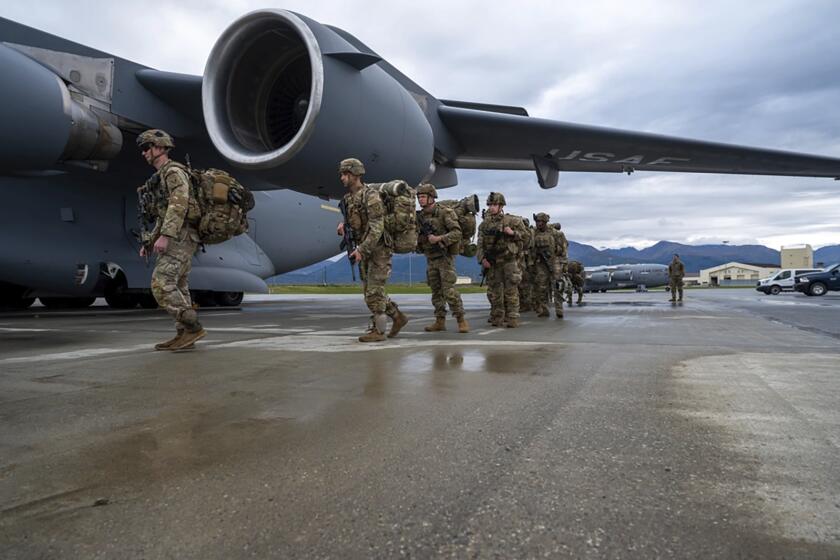Irrigation project aims to help Kandahar thrive again
When the Canadian government’s international assistance agency looked into rebuilding a massive irrigation dam here in early 2007, the initial prospects weren’t encouraging. The site appraisal team couldn’t even get to the dam, 20 miles north of Kandahar in the Arghandab River Valley.
A report by the Canadian International Development Agency called security “very fragile” and warned that the “environment will pose a significant challenge.”
It is even more treacherous now to tread in Arghandab district, the site of major Taliban infiltration routes into Kandahar and the most deadly area of Afghanistan for roadside bombs. But Canada has pushed ahead with a rehabilitation project to reestablish the valley and other areas surrounding Kandahar city as Afghanistan’s breadbasket.
Silt and debris have been dredged from the main canal and small feeder canals, bringing life-giving irrigation to some small farmers and contributing to a bumper pomegranate harvest predicted for this fall. More than 2,000 local Afghans have been hired as workers since the project began in 2009, with a goal of 10,000 workers as the 10-year project expands.
Not even the assassination of the Arghandab district governor, Abdul Jabar, in June or Taliban threats against Afghans who cooperate with Westerners has stopped the steady, if fitful, pace of the project.
“This is the kind of thing that can really make a difference — and the Afghans know it,” said Lisa Vandehei, a former Canadian army sergeant and senior analyst for the project. “It’s something the local people have been begging for for years and years.”
If completed, the irrigation project could produce the kind of social and economic transformation the U.S. military and its allies are struggling to achieve as they try to establish security and governance in Kandahar, the Taliban’s spiritual home.
Water has always been key to development in Afghanistan, an arid country where only 10% of the land is arable. Up to 85% of crop production comes from irrigated land.
The dam and irrigation system would affect 80% of the residents of Kandahar province, Vandehei said. The project could eventually create 60,000 new farm jobs by increasing cultivated land and doubling crop yields.
Of course, irrigation water could well be diverted for use by opium farmers. Nevertheless, the project has the potential to help lure farmers away from opium by making other crops — wheat, pomegranates, grapes, apricots — more productive and profitable.
With a price tag of $47.9 million for the first three years, a successful Dahla Dam Signature Project would be a bargain — especially in light of the $51.5 billion the U.S. has spent on Afghan reconstruction, with modest results.
But the obstacles are overwhelming. Because of perilous security, Afghan district officials conduct government business behind the massive blast walls of a U.S. military compound. Roadside bombs and insurgent ambushes are common, threatening Afghan farmers and workers, as well as U.S. and Canadian forces.
Although insurgents frequently kill or threaten Afghans who work for Westerners, Vandehei said there have been relatively few threats against workers on the dam project. She said no worker has been killed and only one has been injured.
“Local people know the value of the work, and they don’t want to see it stopped,” she said. Local companies are hired for supplies and equipment, giving residents an incentive to help the project succeed.
Security is the responsibility of a private Canadian company contracted by the Canadian government to run the project. However, Vandehei and another Canadian civilian working for the Canadian government are escorted and protected by U.S. or Canadian forces when visiting project sites. They wear body armor and travel in military vehicles or aircraft.
Their focus remains the engineering challenge of rebuilding and modernizing — in the middle of violent insurgency — a decrepit irrigation system built by the U.S. in the 1950s as a foreign aid project and left unattended for decades. Just finding the original engineering plans was a chore. Researchers finally tracked them down in a moldy box in the basement of a corporate library in Boise, Idaho, Vandehei said.
After the U.S. built the Dahla Dam in 1952 and completed the canal irrigation system in 1956, the province bloomed. Farmers exported apricots, pomegranates, grapes and other crops to neighboring countries. A robust irrigation system snaked from the dam through the Arghandab Valley, on through Kandahar city and into the province’s southern deserts.
“People in the area remember or have heard from their parents or grandparents about ‘When it was better — when the system was working,’ ” Vandehei said.
The main canal is 36 miles long. Its 55 sub-canals total 180 miles, in addition to thousands of small tertiary canals.
But three decades of war have left the system a wreck. A third of the reservoir is clogged with silt. Generators, floodgates, culverts, bridges, hydraulic lift systems and other equipment must be replaced or repaired.
“Some of the canals are so clogged they look like roads,” Vandehei said.
Clearing just one sub-canal provides enough irrigation to sustain 400 farming families, she said.
The clearing is done by laborers paid $5 to $10 a day. The project has also hired Afghan engineers, scientists, accountants and heavy equipment operators, boosting the local economy, Vandehei said.
In addition to restoring the dam and canal system, the project is working with farmers to improve irrigation techniques. Seventy percent of the water now flowing through the system is lost to inefficiency and waste, Vandehei said.
A series of wells linked by underground canals has been used by Afghan farmers for centuries to irrigate crops. But each farmer is able to trap and hoard water, losing much of it through evaporation or leaks and denying water to fellow farmers sharing the system.
The project is attempting to develop an equitable means of sharing and distributing irrigation water, Vandehei said. It is also training farmers and local officials to manage the repaired system so that improvements are sustainable.
“Irrigation,” the project report said, “made agriculture possible and led to the past prosperity of Kandahar.”
More to Read
Sign up for Essential California
The most important California stories and recommendations in your inbox every morning.
You may occasionally receive promotional content from the Los Angeles Times.











